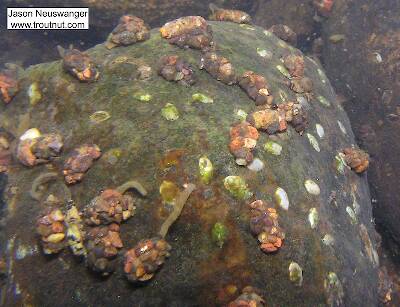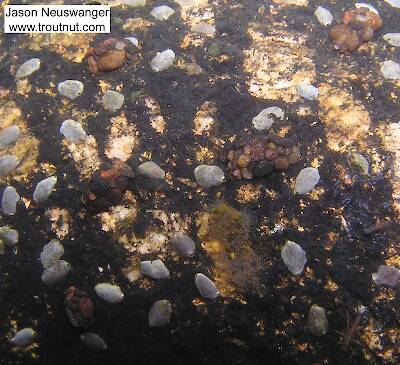
Blue-winged Olives
Baetis
Tiny Baetis mayflies are perhaps the most commonly encountered and imitated by anglers on all American trout streams due to their great abundance, widespread distribution, and trout-friendly emergence habits.


Caddisfly Species Leucotrichia pictipes (Ring Horn Microcaddisflies)
Where & when
This species is abundant across the northern United States. It can be extremely abundant -- Gary LaFontaine tells in Caddisflies of a population estimate putting this species at 5,000 per square foot in parts of the Madison River. If have found it very abundant in the Midwest as well, though probably not quite to that extreme. You can see this in my underwater photos.In 33 records from GBIF, adults of this species have mostly been collected during June (42%), July (27%), August (15%), and May (12%).
In 24 records from GBIF, this species has been collected at elevations ranging from 308 to 6726 ft, with an average (median) of 3412 ft.
Species Range
Egg-Laying behavior
LaFontaine describes the unique egg-laying behavior of this species in Caddisflies:[W]hen the females return to lay their eggs and crawl down the backside of the rocks, so many slip into the currents that trout stack up behind midstream obstructions.
Larva & pupa biology
Current speed: Fast
Identification
Species ID from GBIFthe Global Biodiversity Information Facility
Source: A revision of the Neotropical caddisfly genus Leucotrichia Mosely, 1934 (Hydroptilidae, Leucotrichiinae)
Diagnosis. Leucotrichia pictipes is similar to Leucotrichia fairchildi, Leucotrichia imitator, and Leucotrichia sarita. Leucotrichia pictipes bears patches of scales, both on the dorsum of the head and the eversible membranous lobe beneath the posterolateral wart, which are absent in all 3 of the other species. The genitalia of Leucotrichia pictipes are similar to that Leucotrichia imitator, in having multiple membranous lobes arising from the apex of the phallus. While Leucotrichia imitator has 3 lobes, Leucotrichia pictipes can be distinguished by having 2 sets of symmetrically arranged lobes.
Physical description
Most physical descriptions on Troutnut are direct or slightly edited quotes from the original scientific sources describing or updating the species, although there may be errors in copying them to this website. Such descriptions aren't always definitive, because species often turn out to be more variable than the original describers observed. In some cases, only a single specimen was described! However, they are useful starting points.
Description from GBIFthe Global Biodiversity Information Facility
Source: A revision of the Neotropical caddisfly genus Leucotrichia Mosely, 1934 (Hydroptilidae, Leucotrichiinae)
Description. Male. Length of forewing 2.5 - 4.0 (n = 88). Head with patches of scales dorsally; posterolateral warts large, eversible, with scaled membranous lobes revealed when everted, with 2 ocelli; antennae with scape slightly enlarged, pedicel subtriangular, basal 3 flagellomeres narrow and compact. Dorsum of head brown with yellow setae; thorax brown with yellow setae dorsally, brown ventrally; leg segments with brown setae. Forewings covered with fine brown setae with transverse stripe of yellow setae on basal 1/2 and small scattered patches of yellow setae on distal 1/3. Genitalia. Abdominal sternum VII with mesoventral process replaced by tuft of dense, prominent setae. Sternum VIII in ventral view with posterior margin concave. Segment IX anterolateral margin convex, posterolateral margin convex; in dorsal view anterior margin concave, posterior margin broadly concave. Tergum x with dorsal sclerite slender; ventral sclerite semi-elliptic with tridentate posterior margin; membranous apex not well developed. Subgenital plate with dorsal arm not apparent; ventral arm hollow, apex acute (Fig. 34 A), in ventral view base with crenulate margin, apex rounded. Inferior appendage digitate, bearing single dorsal spine; in ventral view apex rounded. Phallus apex bearing U-shaped internal apodeme, broad ventral sclerite, and 2 pairs of membranous apicodorsal lobes.
2 Underwater Pictures of Leucotrichia pictipes Caddisflies:
Discussions of Leucotrichia pictipes
Start a Discussion of Leucotrichia pictipes
References
- Baumann, Richard W. 1975. Revision of the Stonefly Family Nemouridae (plecoptera) : a Study Of The World Fauna At The Generic Level. Smithsonian Contributions to Zoology undef(211): 1-74.
- LaFontaine, Gary. 1981. Caddisflies. The Lyons Press.
- Swisher, Doug and Carl Richards. 2000. Selective Trout. The Lyons Press.
Caddisfly Species Leucotrichia pictipes (Ring Horn Microcaddisflies)
Species Range
Common Names
Resources
- NatureServe
- Integrated Taxonomic Information System
- Global Biodiversity Information Facility
- Described by Banks (1911)



